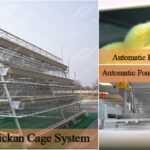Introduction
In the dynamic world of poultry farming, efficient space utilization and streamlined operations are crucial for maximizing productivity. The battery cage system offers a modern solution, revolutionizing poultry farming by optimizing egg production while ensuring the welfare of the birds. This comprehensive installation guide will walk poultry farmers through the essential steps of installing a battery cage system, providing insights into the benefits and considerations associated with this setup. Whether you are a seasoned farmer or new to the industry, mastering the installation of battery cages can significantly enhance your farm’s efficiency and profitability.

Understanding Battery Cage Systems
Battery cage systems are specialized structures designed to house poultry in a controlled environment, maximizing space and facilitating efficient egg production. These systems are widely adopted in commercial poultry farms due to their ability to streamline operations and optimize egg output.
Types of Battery Cage Systems
There are primarily two types of battery cage systems used in poultry farming:
- H-Type Battery Cages. Known for their vertical design, H-type cages allow for more tiers, maximizing the use of vertical space in poultry houses. This design is ideal for larger farms aiming to optimize flock density and egg production efficiency.
- Layer Chicken Cages. Tailored specifically for egg-laying hens, these cages provide a comfortable environment that promotes egg production while keeping the birds safe and healthy. They come in various configurations to accommodate different flock sizes and management styles.

Benefits of Battery Cage Systems
Battery cage systems offer several advantages that contribute to their widespread adoption in the poultry industry:
- Space Efficiency. By utilizing vertical space efficiently, battery cage systems allow farmers to house more birds per square meter of floor space, crucial for large-scale egg production operations.
- Health and Hygiene. These systems maintain a clean environment by separating chickens from their waste and eggs, reducing disease risk and improving overall flock health.
- Labor Efficiency. The structured layout simplifies tasks like egg collection, feeding, and disease management, saving time and labor costs compared to traditional systems.
- Increased Egg Quality and Production. Providing a controlled environment minimizes stress and maximizes comfort, leading to higher egg quality and consistent production rates.
Installation Guide for Battery Cage Systems
Installing a battery cage system requires careful planning and execution to ensure optimal performance. Here’s a step-by-step guide to help you through the process:
Step 1: Preparation
- Assess Farm Size and Capacity. Determine the number of birds you intend to house and the appropriate cage system configuration.
- Select Cage Type. Choose between H-type and layer chicken cages based on your farm’s needs and layout.
- Site Inspection. Conduct a thorough site inspection to ensure the area is suitable for installation, considering factors like ventilation, lighting, and accessibility.

Step 2: Gathering Materials
- Purchase High-Quality Cages. Invest in durable battery cages from reputable suppliers, such as Livi Poultry Equipment Manufacturer, known for their reliability.
- Additional Equipment. Acquire necessary equipment like feeders, drinkers, and waste management systems to complement the cage setup.
Step 3: Installation Process
Installing H-Type Battery Cages
- Foundation Setup: Prepare the foundation by leveling the ground and ensuring proper drainage to prevent water accumulation.
- Frame Assembly: Assemble the cage frames according to the manufacturer’s instructions, ensuring stability and alignment.
- Tier Installation: Install cages tier by tier, securing each level firmly to support the weight of the birds and equipment.
- Feeder and Drinker Setup: Attach feeders and drinkers to each tier, ensuring accessibility for all birds.

Installing Layer Chicken Cages
- Ground Preparation: Level the ground and install a sturdy base to support the cage structure.
- Cage Assembly: Follow the manufacturer’s guidelines to assemble the cages, ensuring each unit is securely fastened.
- Integration of Systems: Install feeding and watering systems, ensuring they are easily accessible and functional.
Step 4: Final Checks and Adjustments
- Inspect Stability: Ensure all cages are stable and secure, with no loose parts or areas prone to collapse.
- Test Systems: Test feeding and watering systems to confirm they are operational and efficient.
- Ventilation and Lighting: Check ventilation systems and lighting to ensure optimal conditions for bird health and productivity.
Factors to Consider When Choosing Battery Cage Systems
When selecting a battery cage system for your poultry farm, consider the following factors to ensure optimal performance and return on investment:

- Climate and Environmental Conditions: Consider local climate factors such as temperature, humidity, and ventilation requirements. Proper ventilation is essential for maintaining bird health and egg production.
- Quality and Durability: Invest in high-quality systems that withstand the rigors of commercial farming. Choose reputable manufacturers for reliable equipment options.
- Cost and Budget Considerations: Compare prices and evaluate the overall cost of ownership, including installation, maintenance, and operational expenses. Prioritize long-term durability and efficiency to maximize profitability.
Conclusion
Investing in a battery cage system for your poultry farm is a strategic decision that can significantly enhance productivity, efficiency, and profitability. By understanding the types, benefits, and installation process, you can make informed decisions that align with your farm’s goals and operational needs. Whether starting a new poultry farm or upgrading existing infrastructure, battery cage systems offer a reliable solution for sustainable egg production in today’s competitive agricultural landscape.
For further assistance and professional installation services, consider partnering with reputable suppliers like Livi Poultry Equipment Manufacturer, ensuring quality equipment and ongoing support to maximize your poultry farming success.
Call to Action
Ready to transform your poultry farm with a battery cage system? Contact us today for expert advice and installation services tailored to your needs. Maximize your farm’s efficiency and productivity with the right equipment and support.






